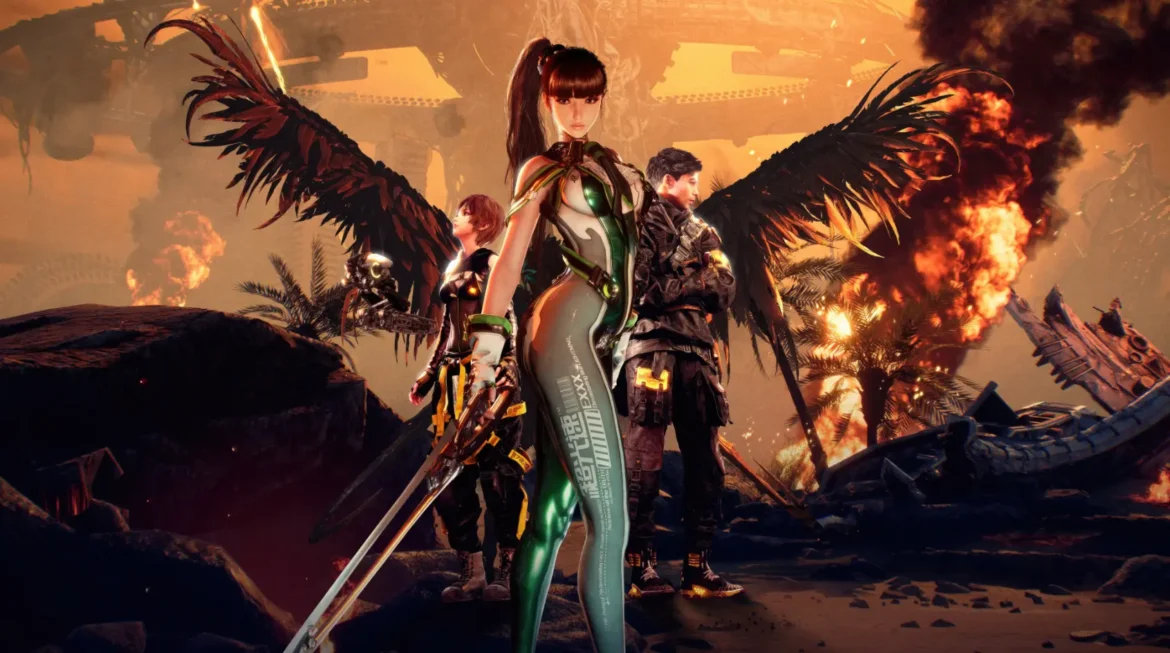Release Date : April 26, 2024
Developer(s) : Shift Up
Publisher(s) : Sony Interactive Entertainment
Platforms : PS5
The Korean market mainly revolves around PC and mobile games, and Shift Up studio is best known for its games for these platforms, such as Nikke: Goddess of Victory, which amassed an impressive sum of money. This was enough to finance a more ambitious project, this time designed for consoles under the name Project EVE, which has now become Stellar Blade. A project that continued to grow and gain recognition, eventually attracting the attention of Sony Interactive Entertainment, who felt the potential and decided to exploit it by becoming the title’s publisher. This brought the title to the international stage. So, was Stellar Blade worthy of such attention? No doubt, but not for its heroine’s attractive appearance, but more for what it offers as an action game.
Storytelling on Autopilot
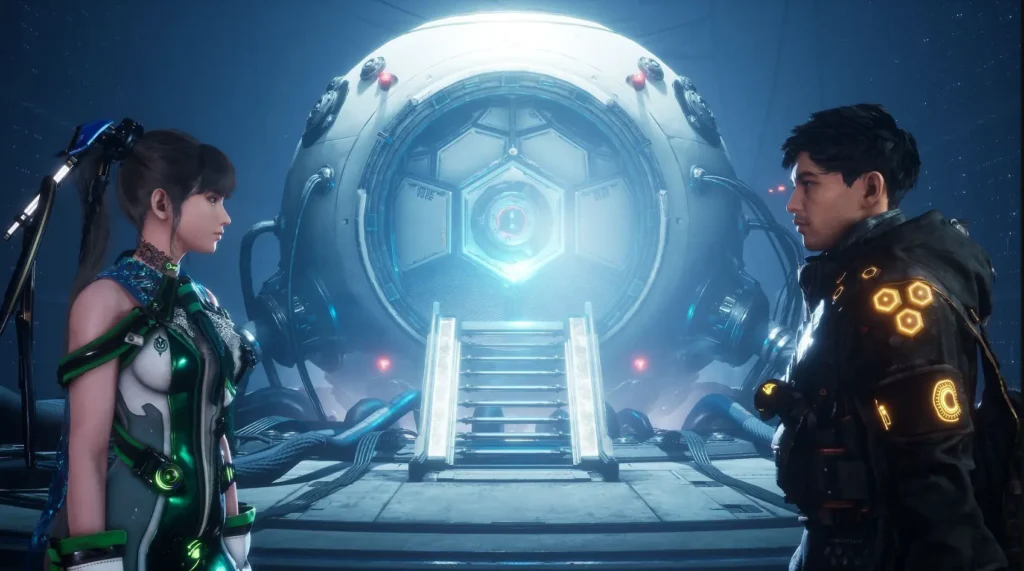
It was clear from the demo, and we’re confirming it today: Stellar Blade wouldn’t exist without NieR Automata, and you can feel it right from the start. First, because it follows the same themes, taking us into a science-fiction story where we are led to reflect on what humanity really is, and what can define it.
In a universe where the Earth has been cleared of almost all humans and even most animals, fashionable-looking “Angels” come from outer space to slaughter monsters called Naytibas, who are the source of the extinction of the human race. EVE is one of these warriors from a distant colony dedicated to finding the source of this species and destroying it. After a rough landing and a tragic accident, our protagonist finds herself teamed up with Adam, one of the last humans on Earth, who asks for her help and takes her to Xion, the last stronghold of mankind.
Stellar Blade’s plot may not be exactly original, but it’s certainly well-executed. You don’t have to wait for dramatic reveals to understand what’s going on in the game, thanks to notes and side quests that help you learn more about the world and its last residents. It’s easy to guess the big plot twists coming our way, leaving us unsurprised by some of the more obvious twists. But thanks to the crazy staging and insane action sequences, we never get bored. Despite that feeling of déjà-vu.
Between life with robots, the search for the Naytibas’ origin, and the duties of the game’s main characters, almost everything is a reminder of the similar themes explored in NieR Automata, but with a little more success, or with more emotion, at least. And that’s probably because of the characters rather than the story itself. EVE in particular.
Style Over Content?
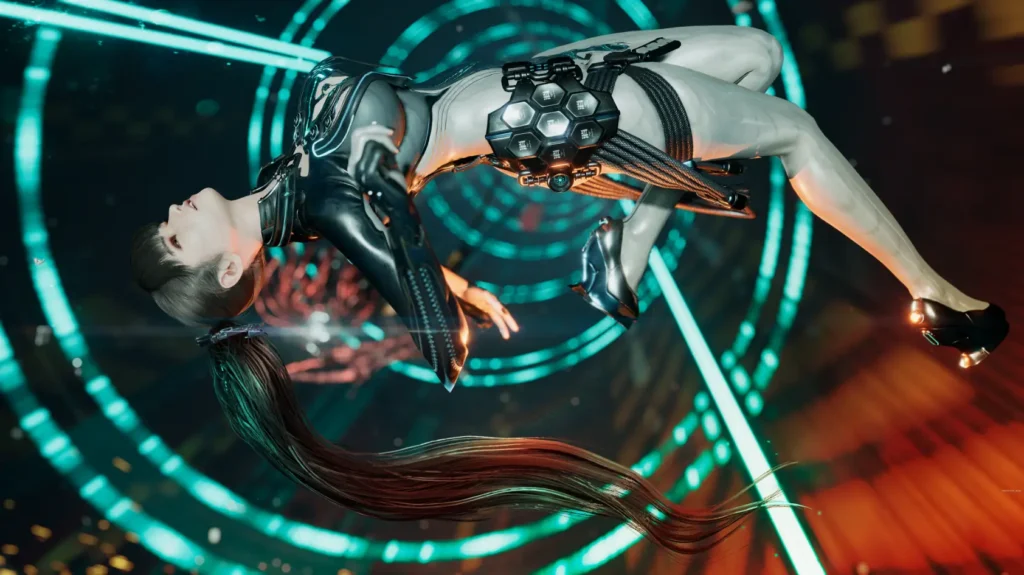
Even if we’re pleased to see that our heroine isn’t just an empty shell designed to satisfy a few fantasies, she still lacks a little depth. Adam and Lily, her two companions, add a little energy to the interactions, which can sometimes be too formal, but it would have been nice to be reminded of EVE’s personality just as much as her looks or the scenes that showcase her athletic abilities, however impressive they may be. If she has what it takes to become an “icon” (that’s a big word to keep in mind), she lacks that little something that makes you care about the character. A sense of humor like Dante, fragility like 2B, an attitude like Bayonetta… Something, anything, a real character trait.
An article published on Inverse described EVE more as a doll than a real protagonist, and while we won’t be so definite thanks to a few scenes that allow her to shine a little brighter on an emotional level, we can understand the idea. This is certainly due to the fact that Stellar Blade devotes so much attention to its heroine’s wardrobe, with over 30 outfits to unlock. You’ll no doubt spend a lot of time collecting these outfits to “dress up” EVE, with costumes that would make 2B or A2 jealous.
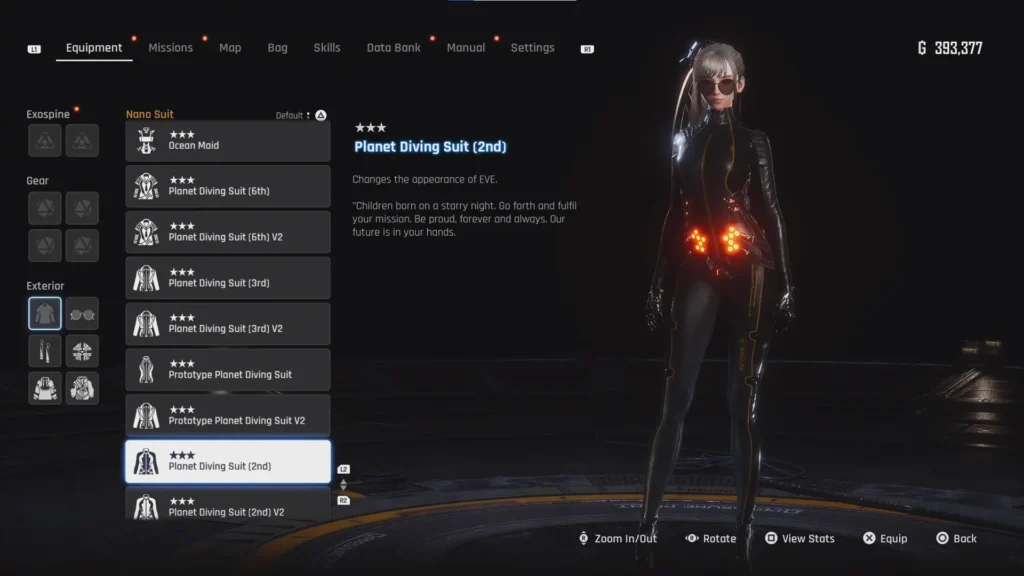
Fortunately, there’s something for everyone here, with more discreet and sometimes even amusing skins, for those who want to avoid panties on every roll or flip. The advantage is that all these outfits are directly integrated into the game (all you need to do is unlock the model and have the resources to craft it) and are not locked behind microtransactions (apart from pre-order bonuses, but we’re only talking about alternative colors). If you’re a fan of this kind of collectibles, Stellar Blade is even more enjoyable.
Gameplay Inspired by Many Different Sources

With so many rewards to collect, exploring Stellar Blade’s semi-open areas can be a real pleasure. Provided you’re not discouraged by the frequency of the battles, with enemies who won’t leave you alone and tend to break the rhythm. Sometimes you’d like to have a little time to admire the desert landscape, without having to get back into action with a monster that’s about to emerge from its hiding place.
In this sense, Stellar Blade is heavily inspired by Souls-like games. Not that it is one, but the approach and placement of enemies is similar to the Japanese studio’s games. You’ll always be looking at your blind spots to avoid a surprise attack. It’s easy to see that this isn’t the only thing the game borrows from From Software’s productions, as Stellar Blade has often been compared to Sekiro, for the simple reason that the heart of combat lies in the parrying system. Blocking blows at the right moment lowers your opponent’s stance gauge, destabilizing him and making him vulnerable.
On the other hand, the parry window isn’t exactly fine-tuned like in Sekiro. The perfect timing is hard to master, sometimes too permissive, sometimes not. However, you do get the hang of it, thanks to skills that extend this window, even if you feel that the whole thing could have been done with a little more precision. The same goes for dodging, with a slow-motion function that activates when a perfect roll is made. It’s not all smooth and precise, but that doesn’t make it unpleasant.
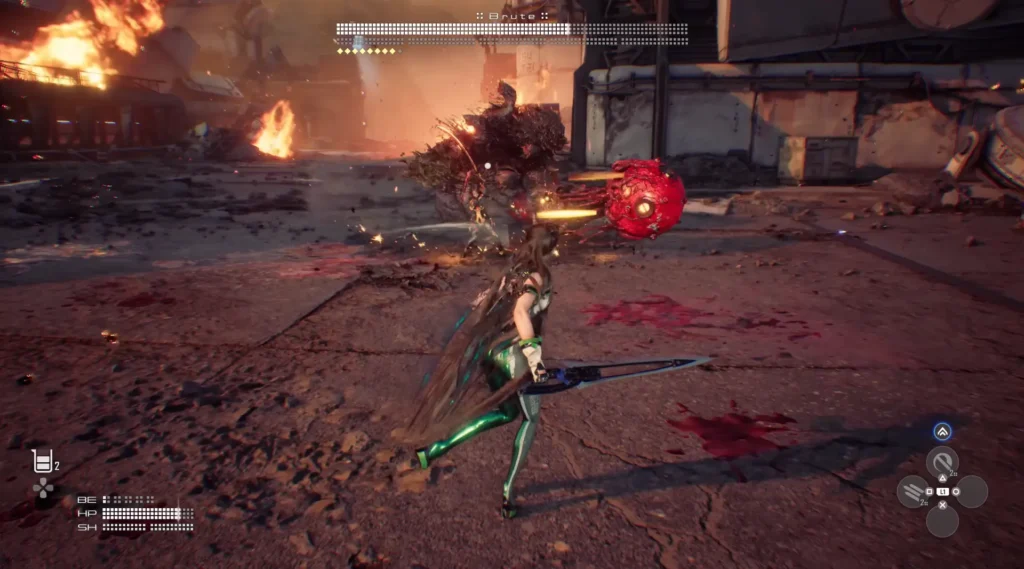
While the initial experience may be challenging, due to EVE’s limited number of actions, Stellar Blade is not a very difficult game by any means, even though death can come easy against some raging bosses that leave no room for mistakes. Thanks to the Story difficulty mode, you won’t be frustrated.
Once you get used to it, the combat system is really entertaining, apart from a few inaccuracies. It’s not exactly fast-paced as some of the videos might have you believe, since it’s essentially based on counters, but it’s still very impressive and full of clever tricks. EVE is more grounded than it looks, but that doesn’t mean it can’t put on a show if you’ve digested everything the game wants you to learn.
Between the different dodges, counterattacks, Beta skills that unleash powerful attacks, equipment with passive effects, and the grenade system, there’s a lot to learn, and the learning curve is well-balanced. EVE can become more powerful with each boss you defeat, but it’s only with your gradual mastery that you’ll feel a real evolution and find it much easier to destroy your enemies.
Blows have an impact, everything is flashy with numerous pyrotechnic effects, and the whole remains fairly easy to read. After thirty hours or so, having covered the entire bestiary, it’s normal to feel a little bored, and we wouldn’t have minded a weapon or two in addition to the simple EVE sword, just to renew the moveset. But it’s still a great system, with only a few annoying flaws, and a solid foundation that’s just waiting to be refined in an eventual second episode.
An Approach Intended to Break New Ground
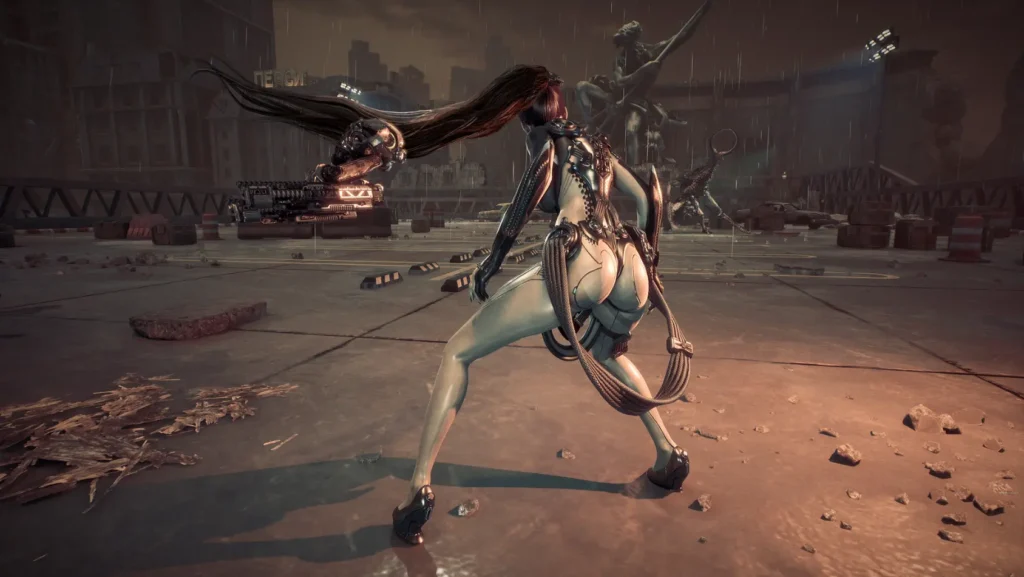
After all, this is only the first Shift Up game of this scale, and impressive as it is, it’s clear that the title’s growing ambition over the course of development has required the studio to explore totally uncharted territory. The game’s structure is a good example. We’d be ready to bet that the title didn’t have any open areas at all for a while, and that everything was supposed to unfold in a straight line.
The reason we feel this is that these open zones ( which are only 2, or let’s say 2 and a half) are hardly exploited by the game’s main plot, if not at all ( again, a bit like Final Fantasy VII Rebirth). The title even denies us access to them in its final third, putting us on track with a structure closer to a beat’em all. This leads to a somewhat clumsy rhythm, even if we do appreciate the presence of these zones, which allow us to break away from the main journey for a while. Whether to find costumes, or to learn more about the world and its inhabitants through side quests.
These additional missions are not all interesting from a gameplay point of view, and tend to recycle bosses, but they do offer a few welcome scraps for the story. None of them are really tedious, and the studio has been clever enough to offer a few options that make it easier to complete them, such as teleporting directly in front of the commanding NPC once the mission objective has been reached. This avoids inflating the lifespan artificially – which is already quite decent – without completely avoiding a few round trips.
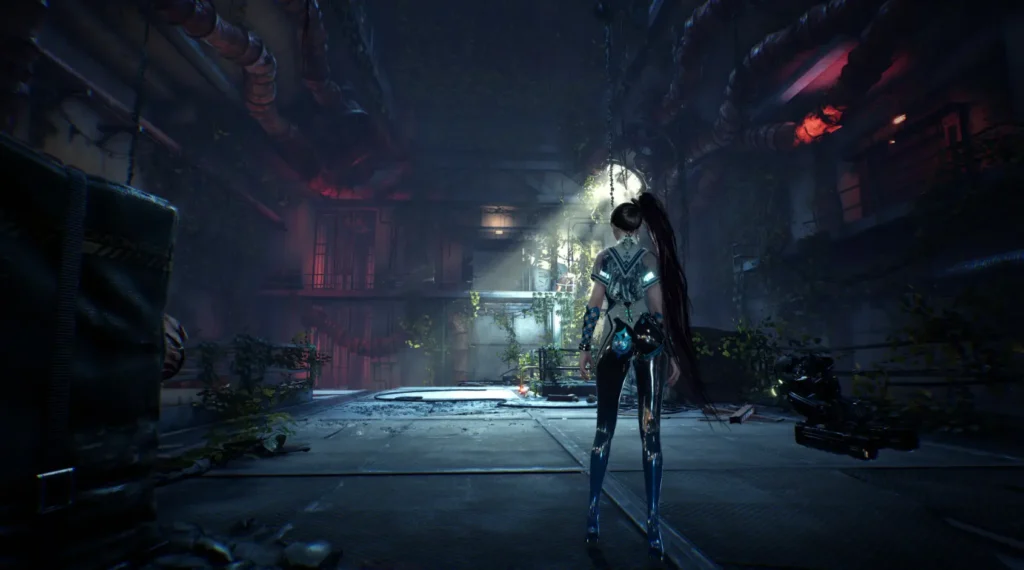
Other activities also encourage exploration, such as a fishing mini-game and soda cans to be collected from all over the world, intending to increase EVE’s abilities (and unlock the most fan-service costume ever). So there’s plenty of reason to explore or return to certain levels. Without sounding like Metroidvania, the game invites us to retrace our steps to solve puzzles or find missing chests, taking a fresh look at the environment.
Moreover, while the same puzzles are presented repeatedly throughout most of the adventure (with passwords to be found and combinations to be entered), and battles eventually end up looking the same, the title sometimes tries to surprise us with more original scenes. From long sliding phases to TPS survival horror sequences and platforming, Stellar Blade tries to offer variety, and deserves credit for it.
Another key point to praise is the studio’s great technical mastery. For a first game of this size, you might expect inexperience to cause a few problems. This is far from being the case, as the game is almost flawless. No bugs to be criticized, and decent framerates in most modes despite a few dips here and there… the Unreal Engine seems to have mastered the art, and Shift Up even offers us some magnificent views and pretty lighting effects in over-the-top sequences. There is a slight lack of inspiration in the artistic direction of certain levels, which take us through classic sewers, parking lots, or factories that lack a little madness. Fortunately, this is not a norm, and the game offers more striking environments, again reminiscent of certain locations in NieR Automata.
Dynamic Symphony
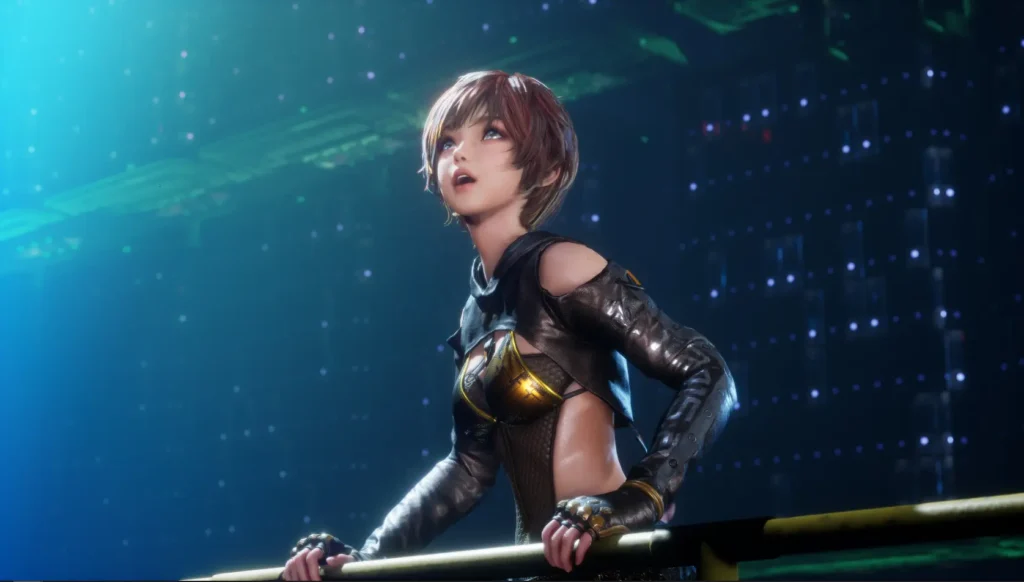
If we’re going to pay homage from beginning to end, we might consider seeking out artists who know Yoko Taro’s work well enough to assume responsibility for the reference. That’s why Shift Up teamed up with Monaca Studio, a group created by Keiichi Okabe, some of whose artists compose part of the game’s soundtrack. While the maestro behind NieR’s striking themes is not directly at the helm here, his colleagues show that they can handle the task just fine without him, while paying tribute to him with familiar-sounding tracks.
For instance, Stellar Blade is blessed with several sung themes that support action and contemplation perfectly, with melodies that are both soft and pop. Monaca Studio’s signature is easy to recognize on several tracks, but it’s the soundtrack as a whole that deserves praise. Stellar Blade doesn’t just copy the musical journey of NieR Automata, it also brings its own little dose of madness with more singular and sometimes angrier tracks, such as a boss theme that goes metal.
And the most interesting is this soundtrack is adaptive, and can evolve according to what’s happening on screen. Like Final Fantasy VII Rebirth, to cite the most recent example, the tempo of a theme will speed up or slow down depending on when EVE is forced to draw her blade. Transitions are perfectly managed, even for sung tracks. A true masterpiece for one of the most successful soundtracks of the new year, and given the competition, it’s quite an achievement.
Conclusion
Stellar Blade may be linked to its sultry image, but there’s more to it than just that. Shift Up achieves a remarkable achievement with its first game of this scale, and has all the ingredients to be one of the best action games of the year. Like EVE, it probably lacks that little something extra that would have made it stand out (apart from the heroine’s attractive appeal) or that would have placed it close to the titles whose inspiration is found everywhere. But the overall result is a very solid production, full of ambition and good intentions, which will certainly serve as a foundation for a license that will remain in the spotlight for a while.
